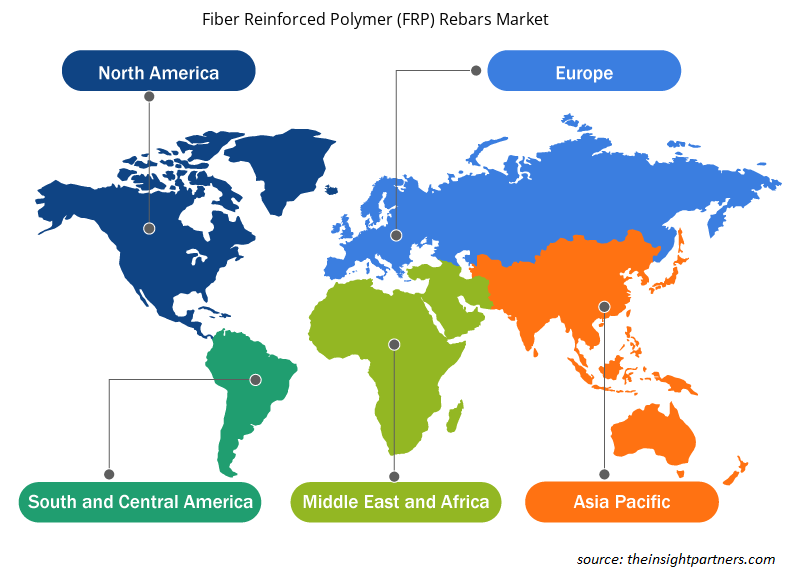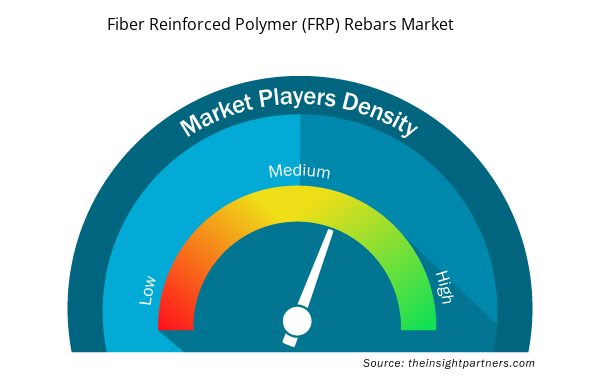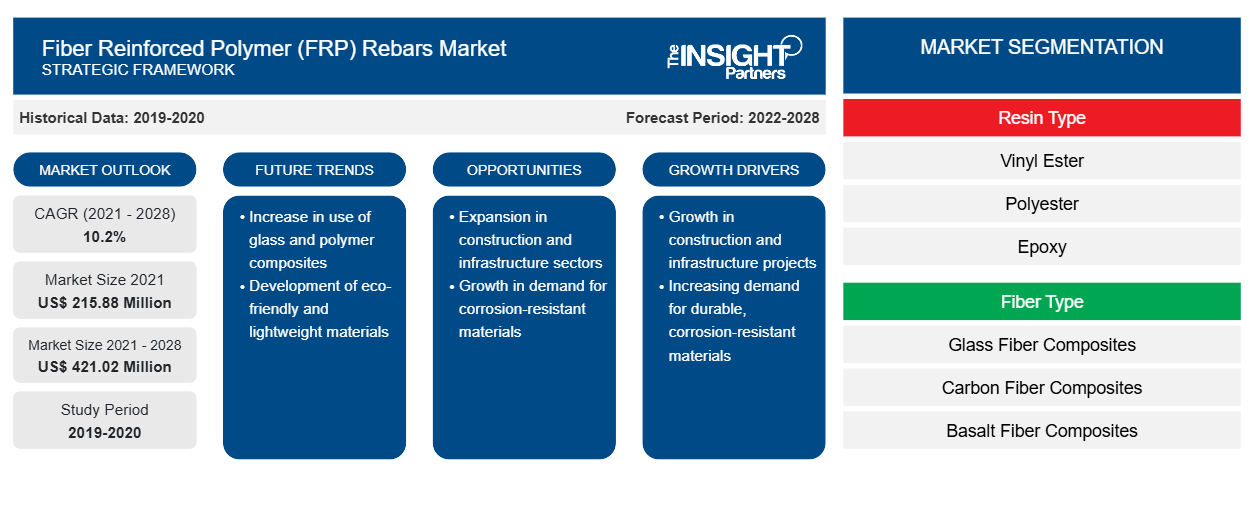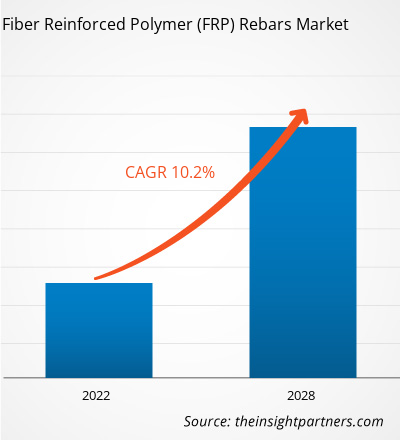Der Markt für Bewehrungsstäbe aus faserverstärktem Kunststoff (FRP) soll von 215,88 Millionen US-Dollar im Jahr 2021 auf 421,02 Millionen US-Dollar im Jahr 2028 wachsen; von 2022 bis 2028 wird mit einer durchschnittlichen jährlichen Wachstumsrate von 10,2 % gerechnet.
Da Beton druckfest, aber zugfest ist, wird er normalerweise verstärkt, um ein zug- und druckfestes Baumaterial zu schaffen. Diese Bewehrung besteht aufgrund der geringen Kosten, der hohen Festigkeit und Elastizität üblicherweise aus Stahl. Stahlkorrosion könnte Regierungen und Vermögenseigentümer jedoch Milliarden von Dollar an Wartungskosten kosten, um veraltete Infrastruktur zu ersetzen oder zu reparieren. Es gibt nur wenige Alternativen für Betonbewehrungsmaterialien, die zur Verhinderung von Korrosion verwendet werden können. Einige Hersteller bieten beispielsweise Bewehrungsstäbe aus rostfreiem Stahl an; faserverstärkte Polymerbewehrungsstäbe können jedoch als korrosionsbeständige Alternative zu herkömmlichen Bewehrungsstäben für Betonbewehrung dienen. Diese FRP-Bewehrungsstäbe werden aus einer Kombination einer Polymermatrix mit Glas-, Kohlenstoff- oder Basaltfasern hergestellt. Diese Materialien rosten nicht, sind viel leichter als Stahl, leiten keine Wärme und sind fast viermal zugfester. Aufgrund seiner Korrosionsbeständigkeit ist faserverstärkter Kunststoff die beste Alternative für verschiedene Bauanwendungen wie Stützmauern, Pfeiler, Anlegestellen, Kais, Senkkästen, Decks, Schotten, Pfähle, Kanäle, Offshore-Plattformen, Schwimmbäder und Aquarien.
Darüber hinaus leiten die nichtleitenden Eigenschaften von Glas und Polymer von FRP-Bewehrungsstäben in elektromagnetisch empfindlichen Anwendungen keinen Strom, ziehen keinen Blitz an und stören nicht den Betrieb von elektrischen Geräten in der Nähe. Das macht faserverstärkten Kunststoff zu einer sichereren Alternative zu Stahl in Aluminium- und Kupferschmelzanlagen, Flughafentürmen, Kernkraftwerken, speziellen Militärstrukturen, Strom- und Telefonmasten, Mannlöchern mit elektrischen oder Telefongeräten und Krankenhäusern mit Magnetresonanztomographie-Geräten (MRT).
Passen Sie diesen Bericht Ihren Anforderungen an
Sie erhalten kostenlos individuelle Anpassungen an jedem Bericht, einschließlich Teilen dieses Berichts oder einer Analyse auf Länderebene, eines Excel-Datenpakets sowie tolle Angebote und Rabatte für Start-ups und Universitäten.
- Holen Sie sich die wichtigsten Markttrends aus diesem Bericht.Dieses KOSTENLOSE Beispiel umfasst eine Datenanalyse von Markttrends bis hin zu Schätzungen und Prognosen.
Markteinblicke
Wachsende Bautätigkeit fördert Wachstum auf dem Markt für Bewehrungsstäbe aus faserverstärktem Kunststoff (FRP)
Die Bauindustrie ist einer der Hauptfaktoren für die wirtschaftliche Entwicklung weltweit. Sie floriert schnell, da die Regierung den Ausbau der Infrastruktur weltweit immer stärker fördert. So plante Indien beispielsweise, von 2019 bis 2023 über die National Infrastructure Pipeline 1,4 Billionen US-Dollar für die Infrastruktur auszugeben. In diese Pipeline hat die Regierung Infrastrukturen wie Strom, Brücken, Dämme, Straßen und den Ausbau der städtischen Infrastruktur aufgenommen. Aufgrund ihrer vorteilhaften Materialeigenschaften wie hohe Festigkeit, Frost- und Tausalztoleranz sowie kurze Installationszeiten bei minimalen Verkehrsbehinderungen haben sich faserverstärkte Kunststoffe zu wertvollen Ersatzbaustoffen für Brückenkonstruktionen entwickelt. Solche Initiativen der Regierungen verschiedener Länder dürften das Wachstum des Marktes für Bewehrungsstäbe aus faserverstärktem Kunststoff (FRP) ankurbeln
Einblicke in den Harztyp
Basierend auf dem Harztyp ist der globale Markt für faserverstärkte Polymerbewehrungsstäbe (FRP) in Vinylester, Polyester, Epoxid und andere unterteilt. Im Jahr 2021 hatte das Vinylestersegment den größten Marktanteil. Vinylesterharze haben eine hohe Festigkeit, eine hohe Beständigkeit gegen Korrosion, Kraftstoffe, Chemikalien oder Dämpfe und bieten mechanische Belastbarkeit. Sie haben eine hohe Haltbarkeit, Hitzebeständigkeit und eine hohe Zugdehnungsfestigkeit. Dieses Harz kann mit Kurzglasfasern oder Kohlenstofffasern imprägniert werden, um FRP-Bewehrungsstäbe herzustellen. Die Mehrheit der Hersteller von faserverstärkten Polymerbewehrungsstäben verwendet Vinylesterharz. Die Kosteneffizienz von Vinylester hat das Wachstum des Segments angekurbelt.
Owens Corning; KODIAC Fiberglass Rebar; MARSHALL COMPOSITE TECHNOLOGIES, LLC; TUF-BAR; Armastek USA; Pultron Composites; FiRep Inc.;PULTRALL, Inc.; Schock Bauteile GmbH; und Dextra Group gehören zu den wichtigsten Akteuren auf dem globalen Markt für faserverstärkte Polymer-Bewehrungsstäbe (GFK). Die führenden Akteure verfolgen Strategien wie Fusionen und Übernahmen sowie Produkteinführungen, um ihre geografische Präsenz und ihren Kundenstamm zu erweitern. So ist Pultron Composites beispielsweise eine Partnerschaft mit Saudi Aramco, dem führenden Ölunternehmen Saudi-Arabiens, eingegangen, um seine Produktionsanlagen für glasfaserverstärkte Polymer-Bewehrungsstäbe (GFK) im Land zu erweitern.
Faserverstärkte Polymer-Bewehrungsstäbe
Regionale Einblicke in den Markt für faserverstärkte Kunststoffbewehrungsstäbe (FRP)
Die regionalen Trends und Faktoren, die den Markt für faserverstärkte Polymer-Bewehrungsstäbe (FRP) während des Prognosezeitraums beeinflussen, wurden von den Analysten von Insight Partners ausführlich erläutert. In diesem Abschnitt werden auch die Marktsegmente und die Geografie für faserverstärkte Polymer-Bewehrungsstäbe (FRP) in Nordamerika, Europa, im asiatisch-pazifischen Raum, im Nahen Osten und Afrika sowie in Süd- und Mittelamerika erörtert.

- Erhalten Sie regionale Daten zum Markt für Bewehrungsstäbe aus faserverstärktem Kunststoff (FRP).
Umfang des Marktberichts zu Bewehrungsstäben aus faserverstärktem Kunststoff (FRP)
| Berichtsattribut | Details |
|---|---|
| Marktgröße im Jahr 2021 | 215,88 Millionen US-Dollar |
| Marktgröße bis 2028 | 421,02 Millionen US-Dollar |
| Globale CAGR (2021 - 2028) | 10,2 % |
| Historische Daten | 2019-2020 |
| Prognosezeitraum | 2022–2028 |
| Abgedeckte Segmente | Nach Harztyp
|
| Abgedeckte Regionen und Länder | Nordamerika
|
| Marktführer und wichtige Unternehmensprofile |
|
Dichte der Marktteilnehmer für faserverstärkte Kunststoffbewehrungsstäbe (FRP): Verständnis ihrer Auswirkungen auf die Geschäftsdynamik
Der Markt für faserverstärkte Polymer-Bewehrungsstäbe (FRP) wächst rasant, angetrieben durch die steigende Nachfrage der Endverbraucher aufgrund von Faktoren wie sich entwickelnden Verbraucherpräferenzen, technologischen Fortschritten und einem größeren Bewusstsein für die Vorteile des Produkts. Mit steigender Nachfrage erweitern Unternehmen ihr Angebot, entwickeln Innovationen, um die Bedürfnisse der Verbraucher zu erfüllen, und nutzen neue Trends, was das Marktwachstum weiter ankurbelt.
Die Marktteilnehmerdichte bezieht sich auf die Verteilung der Firmen oder Unternehmen, die in einem bestimmten Markt oder einer bestimmten Branche tätig sind. Sie gibt an, wie viele Wettbewerber (Marktteilnehmer) in einem bestimmten Marktraum im Verhältnis zu seiner Größe oder seinem gesamten Marktwert präsent sind.
Die wichtigsten auf dem Markt für Bewehrungsstäbe aus faserverstärktem Kunststoff (FRP) tätigen Unternehmen sind:
- Owens Corning
- KODIAC Fiberglas-Bewehrungsstäbe
- MARSHALL COMPOSITE TECHNOLOGIES, LLC.
- TUF-BAR
- ArmaTek USA
Haftungsausschluss : Die oben aufgeführten Unternehmen sind nicht in einer bestimmten Reihenfolge aufgeführt.

- Überblick über die wichtigsten Akteure auf dem Markt für faserverstärkte Kunststoffbewehrungsstäbe (FRP)
Bericht-Spotlights
- Progressive Trends in der Branche für Bewehrungsstäbe aus faserverstärktem Kunststoff (FRP) sollen den Akteuren bei der Entwicklung wirksamer langfristiger Strategien helfen
- Von Unternehmen verfolgte Geschäftswachstumsstrategien zur Sicherung des Wachstums in entwickelten und sich entwickelnden Märkten
- Quantitative Analyse des globalen Marktes für Bewehrungsstäbe aus faserverstärktem Kunststoff (FRP) von 2022 bis 2028
- Schätzung der Nachfrage nach Bewehrungsstäben aus faserverstärktem Kunststoff (FRP)
- Porters Analyse zur Veranschaulichung der Wirksamkeit von Käufern und Lieferanten in der Branche, um das Marktwachstum vorherzusagen
- Aktuelle Entwicklungen zum Verständnis des Wettbewerbsmarktszenarios und der Nachfrage nach Bewehrungsstäben aus faserverstärktem Kunststoff (FRP)
- Markttrends und -aussichten sowie Faktoren, die das Wachstum des globalen Marktes für faserverstärkte Kunststoffbewehrungsstäbe (FRP) vorantreiben und bremsen
- Verständnis der Strategien, die dem kommerziellen Interesse im Hinblick auf das Wachstum des globalen Marktes für faserverstärkte Kunststoff-Bewehrungsstäbe (FRP) zugrunde liegen, als Unterstützung für den Entscheidungsprozess
- Globale Marktgröße für faserverstärkte Kunststoffbewehrungsstäbe (FRP) an verschiedenen Marktknoten
- Detaillierte Übersicht und Segmentierung des globalen Marktes für faserverstärkte Polymerbewehrungsstäbe (FRP) und seiner Branchendynamik
- Globale Marktgröße für Bewehrungsstäbe aus faserverstärktem Kunststoff (FRP) in verschiedenen Regionen mit vielversprechenden Wachstumschancen
Die „Marktanalyse für faserverstärkte Polymer-Bewehrungsstäbe (FRP) bis 2028“ ist eine spezialisierte und eingehende Studie der Chemie- und Materialindustrie, die sich auf die Trendanalyse des Marktes für faserverstärkte Polymer-Bewehrungsstäbe (FRP) konzentriert. Der Bericht soll einen Überblick über den Markt mit detaillierter Segmentierung geben. Der Markt für faserverstärkte Polymer-Bewehrungsstäbe (FRP) ist nach Harztyp, Fasertyp, Anwendung und Geografie segmentiert. Basierend auf dem Harztyp ist der Markt in Vinylester, Polyester, Epoxid und andere segmentiert. Basierend auf dem Fasertyp ist der Markt in Glasfaserverbundstoffe, Kohlenstofffaserverbundstoffe und Basaltfaserverbundstoffe segmentiert. Basierend auf der Anwendung ist der Markt in Autobahnbrücken und -bau, Meeresstrukturen und Ufergebiete, Wasseraufbereitungsanlagen und andere segmentiert. Basierend auf der Geografie ist der Markt in fünf Hauptregionen segmentiert – Nordamerika, Europa, Asien-Pazifik, Naher Osten und Afrika sowie Süd- und Mittelamerika. Im Jahr 2021 dominierte Nordamerika den Markt für faserverstärkte Polymer-Bewehrungsstäbe (FRP). Allerdings wird erwartet, dass der asiatisch-pazifische Raum im Prognosezeitraum die höchste durchschnittliche jährliche Wachstumsrate (CAGR) auf dem Markt verzeichnen wird.
- Historische Analyse (2 Jahre), Basisjahr, Prognose (7 Jahre) mit CAGR
- PEST- und SWOT-Analyse
- Marktgröße Wert/Volumen – Global, Regional, Land
- Branche und Wettbewerbsumfeld
- Excel-Datensatz


- Real-Time Location Systems Market
- Visualization and 3D Rendering Software Market
- Health Economics and Outcome Research (HEOR) Services Market
- GMP Cytokines Market
- Collagen Peptides Market
- Battery Testing Equipment Market
- Electronic Shelf Label Market
- Precast Concrete Market
- Semiconductor Metrology and Inspection Market
- Long Read Sequencing Market

Report Coverage
Revenue forecast, Company Analysis, Industry landscape, Growth factors, and Trends

Segment Covered
This text is related
to segments covered.

Regional Scope
North America, Europe, Asia Pacific, Middle East & Africa, South & Central America

Country Scope
This text is related
to country scope.
Häufig gestellte Fragen
In 2021, North America accounted for the largest share of the global fiber reinforced polymer (FRP) rebars market. Increasing government spending on infrastructure development and increased adoption of FRP rebars in construction led to the dominance of North America in 2021.
The major players operating in the fiber reinforced polymer (FRP) rebars market are Owens Corning; KODIAC Fiberglass Rebar; Marshall Composite Technologies, LLC; TUF-BAR; Armastek USA; Pultron Composites; FiRep Inc.; Pultrall, Inc.; Schock Bauteile GmbH; and Dextra Group.
In 2021, the vinyl ester segment held the largest market share. Vinyl ester resins have high strength, high resistance to corrosion, and resistance to fuels, mechanical toughness, chemicals, or vapors. They have great durability, heat resistance, and high tensile elongation strength. This resin can be impregnated with short glass fiber or carbon fiber to produce FRP rebars. The majority of FRP rebar manufacturers use vinyl ester resin. The cost-effectiveness of vinyl ester has led to the segment's dominance in 2021.
In 2021, the highway bridge and construction held the largest market share. Growing demand for restoration and strengthening of the existing deficient structures, along with increasing transportation accompanied by rapid industrialization and urbanization in the emerging economies, has positively influenced the product penetration leading to the dominance of the highway bridge and construction segment in 2021.
Fiber reinforced polymer rebar is a non-corrosive alternative for steel rebar in concrete reinforcement. Advanced thermal compatibility also provides zero stress while responding to temperature changes, which is expected to positively influence the global fiber reinforced polymer (FRP) rebars market during the forecast period. Additional advantages of FRP rebars include excellent quality control with reduced transportation costs which is slated to favor its demand.
During the forecast period, the basalt fiber composites segment is expected to be the fastest-growing segment. Basalt fiber composite is a new alternative to conventionally used fibers such as glass fiber composite, and some extent, carbon fiber composite. These are characterized by superior resistance against low and high temperatures. Moreover, an increase in the use of natural fiber composites such as basalt fiber in automotive & transportation, construction & infrastructure, electrical & electronics, and other end-use industries is expected to propel the growth of the basalt fiber composites demand.
Trends and growth analysis reports related to Chemicals and Materials : READ MORE..
The List of Companies - Fiber Reinforced Polymer (FRP) Rebars Market
- Owens Corning
- KODIAC Fiberglass Rebar
- MARSHALL COMPOSITE TECHNOLOGIES, LLC.
- TUF-BAR
- Armastek USA
- Pultron Composites
- FiRep Inc.
- PULTRALL, Inc.
- Schock Bauteile GmbH
- Dextra Group
The Insight Partners performs research in 4 major stages: Data Collection & Secondary Research, Primary Research, Data Analysis and Data Triangulation & Final Review.
- Data Collection and Secondary Research:
As a market research and consulting firm operating from a decade, we have published and advised several client across the globe. First step for any study will start with an assessment of currently available data and insights from existing reports. Further, historical and current market information is collected from Investor Presentations, Annual Reports, SEC Filings, etc., and other information related to company’s performance and market positioning are gathered from Paid Databases (Factiva, Hoovers, and Reuters) and various other publications available in public domain.
Several associations trade associates, technical forums, institutes, societies and organization are accessed to gain technical as well as market related insights through their publications such as research papers, blogs and press releases related to the studies are referred to get cues about the market. Further, white papers, journals, magazines, and other news articles published in last 3 years are scrutinized and analyzed to understand the current market trends.
- Primary Research:
The primarily interview analysis comprise of data obtained from industry participants interview and answers to survey questions gathered by in-house primary team.
For primary research, interviews are conducted with industry experts/CEOs/Marketing Managers/VPs/Subject Matter Experts from both demand and supply side to get a 360-degree view of the market. The primary team conducts several interviews based on the complexity of the markets to understand the various market trends and dynamics which makes research more credible and precise.
A typical research interview fulfils the following functions:
- Provides first-hand information on the market size, market trends, growth trends, competitive landscape, and outlook
- Validates and strengthens in-house secondary research findings
- Develops the analysis team’s expertise and market understanding
Primary research involves email interactions and telephone interviews for each market, category, segment, and sub-segment across geographies. The participants who typically take part in such a process include, but are not limited to:
- Industry participants: VPs, business development managers, market intelligence managers and national sales managers
- Outside experts: Valuation experts, research analysts and key opinion leaders specializing in the electronics and semiconductor industry.
Below is the breakup of our primary respondents by company, designation, and region:

Once we receive the confirmation from primary research sources or primary respondents, we finalize the base year market estimation and forecast the data as per the macroeconomic and microeconomic factors assessed during data collection.
- Data Analysis:
Once data is validated through both secondary as well as primary respondents, we finalize the market estimations by hypothesis formulation and factor analysis at regional and country level.
- Macro-Economic Factor Analysis:
We analyse macroeconomic indicators such the gross domestic product (GDP), increase in the demand for goods and services across industries, technological advancement, regional economic growth, governmental policies, the influence of COVID-19, PEST analysis, and other aspects. This analysis aids in setting benchmarks for various nations/regions and approximating market splits. Additionally, the general trend of the aforementioned components aid in determining the market's development possibilities.
- Country Level Data:
Various factors that are especially aligned to the country are taken into account to determine the market size for a certain area and country, including the presence of vendors, such as headquarters and offices, the country's GDP, demand patterns, and industry growth. To comprehend the market dynamics for the nation, a number of growth variables, inhibitors, application areas, and current market trends are researched. The aforementioned elements aid in determining the country's overall market's growth potential.
- Company Profile:
The “Table of Contents” is formulated by listing and analyzing more than 25 - 30 companies operating in the market ecosystem across geographies. However, we profile only 10 companies as a standard practice in our syndicate reports. These 10 companies comprise leading, emerging, and regional players. Nonetheless, our analysis is not restricted to the 10 listed companies, we also analyze other companies present in the market to develop a holistic view and understand the prevailing trends. The “Company Profiles” section in the report covers key facts, business description, products & services, financial information, SWOT analysis, and key developments. The financial information presented is extracted from the annual reports and official documents of the publicly listed companies. Upon collecting the information for the sections of respective companies, we verify them via various primary sources and then compile the data in respective company profiles. The company level information helps us in deriving the base number as well as in forecasting the market size.
- Developing Base Number:
Aggregation of sales statistics (2020-2022) and macro-economic factor, and other secondary and primary research insights are utilized to arrive at base number and related market shares for 2022. The data gaps are identified in this step and relevant market data is analyzed, collected from paid primary interviews or databases. On finalizing the base year market size, forecasts are developed on the basis of macro-economic, industry and market growth factors and company level analysis.
- Data Triangulation and Final Review:
The market findings and base year market size calculations are validated from supply as well as demand side. Demand side validations are based on macro-economic factor analysis and benchmarks for respective regions and countries. In case of supply side validations, revenues of major companies are estimated (in case not available) based on industry benchmark, approximate number of employees, product portfolio, and primary interviews revenues are gathered. Further revenue from target product/service segment is assessed to avoid overshooting of market statistics. In case of heavy deviations between supply and demand side values, all thes steps are repeated to achieve synchronization.
We follow an iterative model, wherein we share our research findings with Subject Matter Experts (SME’s) and Key Opinion Leaders (KOLs) until consensus view of the market is not formulated – this model negates any drastic deviation in the opinions of experts. Only validated and universally acceptable research findings are quoted in our reports.
We have important check points that we use to validate our research findings – which we call – data triangulation, where we validate the information, we generate from secondary sources with primary interviews and then we re-validate with our internal data bases and Subject matter experts. This comprehensive model enables us to deliver high quality, reliable data in shortest possible time.


 Holen Sie sich ein kostenloses Muster für diesen Bericht
Holen Sie sich ein kostenloses Muster für diesen Bericht